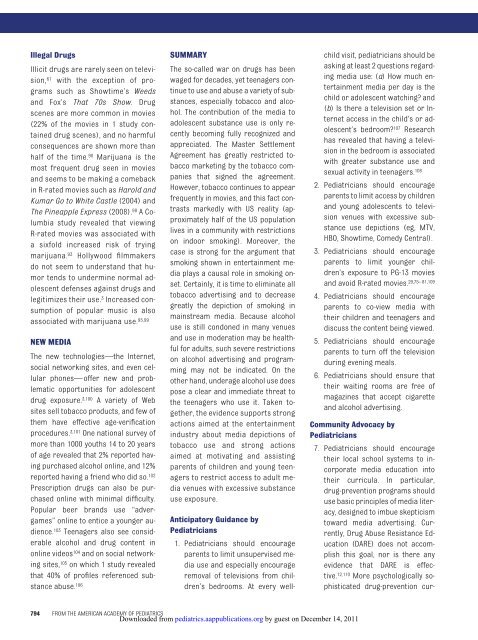Children, Adolescents, Substance Abuse, and the Media
Children, Adolescents, Substance Abuse, and the Media
Children, Adolescents, Substance Abuse, and the Media
Create successful ePaper yourself
Turn your PDF publications into a flip-book with our unique Google optimized e-Paper software.
Illegal DrugsIllicit drugs are rarely seen on television,61 with <strong>the</strong> exception of programssuch as Showtime’s Weeds<strong>and</strong> Fox’s That 70s Show. Drugscenes are more common in movies(22% of <strong>the</strong> movies in 1 study containeddrug scenes), <strong>and</strong> no harmfulconsequences are shown more thanhalf of <strong>the</strong> time. 90 Marijuana is <strong>the</strong>most frequent drug seen in movies<strong>and</strong> seems to be making a comebackin R-rated movies such as Harold <strong>and</strong>Kumar Go to White Castle (2004) <strong>and</strong>The Pineapple Express (2008). 98 A Columbiastudy revealed that viewingR-rated movies was associated witha sixfold increased risk of tryingmarijuana. 93 Hollywood filmmakersdo not seem to underst<strong>and</strong> that humortends to undermine normal adolescentdefenses against drugs <strong>and</strong>legitimizes <strong>the</strong>ir use. 3 Increased consumptionof popular music is alsoassociated with marijuana use. 95,99NEW MEDIAThe new technologies—<strong>the</strong> Internet,social networking sites, <strong>and</strong> even cellularphones—offer new <strong>and</strong> problematicopportunities for adolescentdrug exposure. 3,100 A variety of Websites sell tobacco products, <strong>and</strong> few of<strong>the</strong>m have effective age-verificationprocedures. 3,101 One national survey ofmore than 1000 youths 14 to 20 yearsof age revealed that 2% reported havingpurchased alcohol online, <strong>and</strong> 12%reported having a friend who did so. 102Prescription drugs can also be purchasedonline with minimal difficulty.Popular beer br<strong>and</strong>s use “advergames”online to entice a younger audience.103 Teenagers also see considerablealcohol <strong>and</strong> drug content inonline videos 104 <strong>and</strong> on social networkingsites, 105 on which 1 study revealedthat 40% of profiles referenced substanceabuse. 106SUMMARYThe so-called war on drugs has beenwaged for decades, yet teenagers continueto use <strong>and</strong> abuse a variety of substances,especially tobacco <strong>and</strong> alcohol.The contribution of <strong>the</strong> media toadolescent substance use is only recentlybecoming fully recognized <strong>and</strong>appreciated. The Master SettlementAgreement has greatly restricted tobaccomarketing by <strong>the</strong> tobacco companiesthat signed <strong>the</strong> agreement.However, tobacco continues to appearfrequently in movies, <strong>and</strong> this fact contrastsmarkedly with US reality (approximatelyhalf of <strong>the</strong> US populationlives in a community with restrictionson indoor smoking). Moreover, <strong>the</strong>case is strong for <strong>the</strong> argument thatsmoking shown in entertainment mediaplays a causal role in smoking onset.Certainly, it is time to eliminate alltobacco advertising <strong>and</strong> to decreasegreatly <strong>the</strong> depiction of smoking inmainstream media. Because alcoholuse is still condoned in many venues<strong>and</strong> use in moderation may be healthfulfor adults, such severe restrictionson alcohol advertising <strong>and</strong> programmingmay not be indicated. On <strong>the</strong>o<strong>the</strong>r h<strong>and</strong>, underage alcohol use doespose a clear <strong>and</strong> immediate threat to<strong>the</strong> teenagers who use it. Taken toge<strong>the</strong>r,<strong>the</strong> evidence supports strongactions aimed at <strong>the</strong> entertainmentindustry about media depictions oftobacco use <strong>and</strong> strong actionsaimed at motivating <strong>and</strong> assistingparents of children <strong>and</strong> young teenagersto restrict access to adult mediavenues with excessive substanceuse exposure.Anticipatory Guidance byPediatricians1. Pediatricians should encourageparents to limit unsupervised mediause <strong>and</strong> especially encourageremoval of televisions from children’sbedrooms. At every wellchildvisit, pediatricians should beasking at least 2 questions regardingmedia use: (a) How much entertainmentmedia per day is <strong>the</strong>child or adolescent watching? <strong>and</strong>(b) Is <strong>the</strong>re a television set or Internetaccess in <strong>the</strong> child’s or adolescent’sbedroom? 107 Researchhas revealed that having a televisionin <strong>the</strong> bedroom is associatedwith greater substance use <strong>and</strong>sexual activity in teenagers. 1082. Pediatricians should encourageparents to limit access by children<strong>and</strong> young adolescents to televisionvenues with excessive substanceuse depictions (eg, MTV,HBO, Showtime, Comedy Central).3. Pediatricians should encourageparents to limit younger children’sexposure to PG-13 movies<strong>and</strong> avoid R-rated movies. 29,75–81,1094. Pediatricians should encourageparents to co-view media with<strong>the</strong>ir children <strong>and</strong> teenagers <strong>and</strong>discuss <strong>the</strong> content being viewed.5. Pediatricians should encourageparents to turn off <strong>the</strong> televisionduring evening meals.6. Pediatricians should ensure that<strong>the</strong>ir waiting rooms are free ofmagazines that accept cigarette<strong>and</strong> alcohol advertising.Community Advocacy byPediatricians7. Pediatricians should encourage<strong>the</strong>ir local school systems to incorporatemedia education into<strong>the</strong>ir curricula. In particular,drug-prevention programs shoulduse basic principles of media literacy,designed to imbue skepticismtoward media advertising. Currently,Drug <strong>Abuse</strong> Resistance Education(DARE) does not accomplishthis goal, nor is <strong>the</strong>re anyevidence that DARE is effective.12,110 More psychologically sophisticateddrug-prevention cur-794 FROM THE AMERICAN ACADEMY OF PEDIATRICSDownloaded from pediatrics.aappublications.org by guest on December 14, 2011
















